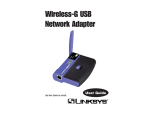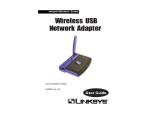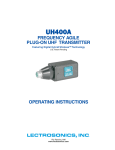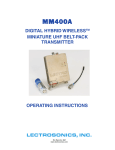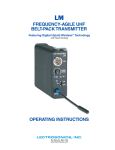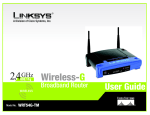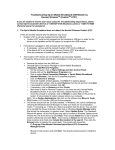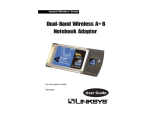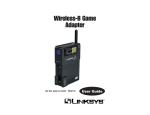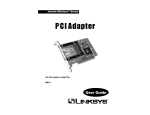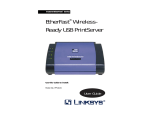Download Linksys WPC11 User's Manual
Transcript
Instant Wireless® Series Wireless-B Notebook Adapter Use this Guide to install: WPC11 User Guide COPYRIGHT & TRADEMARKS Copyright © 2002 Linksys, All Rights Reserved. Instant Wireless, Linksys, and the Linksys logo are registered trademarks of Linksys Group, Inc. Microsoft, Windows, and the Windows logo are registered trademarks of Microsoft Corporation. All other trademarks and brand names are the property of their respective proprietors. INDUSTRY CANADA (CANADA) This Class B digital apparatus complies with Canadian ICES-003. Cet appareil numérique de la classe B est conforme à la norme NMB-003 du Canada. The use of this device in a system operating either partially or completely outdoors may require the user to obtain a license for the system according to the Canadian regulations. LIMITED WARRANTY Linksys guarantees that every Instant Wireless® Wireless-B Notebook Adapter is free from physical defects in material and workmanship for one year from the date of purchase, when used within the limits set forth in the Specifications chapter of this User Guide. If these products prove defective during this warranty period, call Linksys Technical Support in order to obtain a Return Authorization Number. BE SURE TO HAVE YOUR PROOF OF PURCHASE AND A BARCODE FROM THE PRODUCT’S PACKAGING ON HAND WHEN CALLING. RETURN REQUESTS CANNOT BE PROCESSED WITHOUT PROOF OF PURCHASE. When returning a product, mark the Return Authorization Number clearly on the outside of the package and include your original proof of purchase. All customers located outside of the United States of America and Canada shall be held responsible for shipping and handling charges. EC DECLARATION OF CONFORMITY (EUROPE) Linksys Group declares that the Instant Wireless™ Series products included in the Instant Wireless™ Series conform to the specifications listed below, following the provisions of the EMC Directive 89/336/EEC and Low Voltage Directive 73/23/EEC: IN NO EVENT SHALL LINKSYS’ LIABILITY EXCEED THE PRICE PAID FOR THE PRODUCT FROM DIRECT, INDIRECT, SPECIAL, INCIDENTAL, OR CONSEQUENTIAL DAMAGES RESULTING FROM THE USE OF THE PRODUCT, ITS ACCOMPANYING SOFTWARE, OR ITS DOCUMENTATION. LINKSYS DOES NOT OFFER REFUNDS FOR ANY PRODUCT. Linksys makes no warranty or representation, expressed, implied, or statutory, with respect to its products or the contents or use of this documentation and all accompanying software, and specifically disclaims its quality, performance, merchantability, or fitness for any particular purpose. Linksys reserves the right to revise or update its products, software, or documentation without obligation to notify any individual or entity. Please direct all inquiries to: Linksys P.O. Box 18558, Irvine, CA 92623. FCC STATEMENT This product has been tested and complies with the specifications for a Class B digital device, pursuant to Part 15 of the FCC Rules. These limits are designed to provide reasonable protection against harmful interference in a residential installation. The antenna used for this transmitter must be installed to provide a separation distance of at least 20 centimeters from all persons and must operate in conjunction with other antenna or transmitters. This equipment generates, uses, and can radiate radio frequency energy and, if not installed and used according to the instructions, may cause harmful interference to radio communications. However, there is no guarantee that interference will not occur in a particular installation. If this equipment does cause harmful interference to radio or television reception, which is found by turning the equipment off and on, the user is encouraged to try to correct the interference by one or more of the following measures: • • • • Reorient or relocate the receiving antenna Increase the separation between the equipment or devices Connect the equipment to an outlet other than the receiver’s Consult a dealer or an experienced radio/TV technician for assistance UG-WPC11v4-30307NC ET ETS 300-826, 301 489-1 General EMC requirements for Radio equipment. EN 609 50 Safety ETS 300-328-2 Technical requirements for Radio equipment. Note: This equipment is intended to be used in all EU and EFTA countries. Outdoor use may be restricted to certain frequencies and/or may require a license for operation. For more details, contact Linksys Corporate Compliance. Note: Combinations of power levels and antennas resulting in a radiated power level of above 100 mW are considered as not compliant with the above mentioned directive and are not allowed for use within the European community and countries that have adopted the European R&TTE directive 1999/5/EC and/or the CEPT recommendation Rec 70.03. For more details on legal combinations of power levels and antennas, contact Linksys Corporate Compliance. Linksys Group™ vakuuttaa täten että Instant Wireless IEEE 802.11 PC Card tyyppinen laite on direktiivin 1999/5/EY, direktiivin 89/336/EEC ja direktiivin 73/23/EEC oleellisten vaatimusten ja sitä koskevien näiden direktiivien muiden ehtojen mukainen. Linksys Group™ déclare que la carte PC Instant Wireless IEEE 802.11 est conforme aux conditions essentielles et aux dispositions relatives à la directive 1999/5/EC, la directive 89/336/EEC, et à la directive 73/23/EEC. Belgique B L’utilisation en extérieur est autorisé sur le canal 11 (2462 MHz), 12 (2467 MHz), et 13 (2472 MHz). Dans le cas d’une utilisation privée, à l’extérieur d’un bâtiment, au-dessus d’un espace public, aucun enregistrement n’est nécessaire pour une distance de moins de 300m. Pour une distance supérieure à 300m un enregistrement auprès de l’IBPT est requise. Pour une utilisation publique à l’extérieur de bâtiments, une licence de l’IBPT est requise. Pour les enregistrements et licences, veuillez contacter l’IBPT. France F: Bande de fréquence restreinte: seuls les canaux 10, 11, 12, 13 (2457, 2462, 2467, et 2472 MHz respectivement) doivent être utilisés en France. Toute utilisation, qu'elle soit intérieure ou extérieure, est soumise à autorisation. Vous pouvez contacter l'Autorité de Régulation des Télécommuniations (<http://www.art-telecom.fr>) pour la procédure à suivre. France F: Restricted frequency band: only channels 10, 11, 12, 13 (2457, 2462, 2467, and 2472 MHz respectively) may be used in France. License required for every indoor and outdoor installations. Please contact ART for procedure to follow. Deutschland D: Anmeldung im Outdoor-Bereich notwending, aber nicht genehmigungspflichtig. Bitte mit Händler die Vorgehensweise abstimmen. Germany D: License required for outdoor installations. Check with reseller for procedure to follow Italia I: E' necessaria la concessione ministeriale anche per l'uso interno. Verificare con i rivenditori la procedura da seguire. L'uso per installazione in esterni non e' permessa. Italy I: License required for indoor use. Use with outdoor installations not allowed. the Netherlands NL License required for outdoor installations. Check with reseller for procedure to follow. Nederlands NL Licentie verplicht voor gebruik met buitenantennes. Neem contact op met verkoper voor juiste procedure Table of Contents Chapter 1: Introduction The Wireless-B Notebook Adapter Features 1 1 1 Chapter 2: Planning Your Wireless Network Network Topology Ad-Hoc versus Infrastructure Mode 2 2 2 Chapter 3: Getting to Know the Wireless-B Notebook Adapter The Adapter’s LEDs 4 4 Chapter 4: Using the Setup Wizard to Configure Windows 98SE, Me, and 2000 5 Chapter 5: Hardware Installation 9 Chapter 6: Driver Installation and Configuration for Windows XP Overview Driver Installation for Windows XP Windows XP Wireless Zero Configuration 10 10 10 12 Chapter 7: Using the WLAN Monitor for Windows 98SE, Me, and 2000 Overview Accessing the WLAN Monitor Link Information Site Survey Profiles Creating a New Profile 14 14 14 15 17 19 21 Appendix A: Troubleshooting Common Problems and Solutions Frequently Asked Questions 27 27 28 Appendix B: Glossary 32 Appendix C: Specifications Environmental 40 40 Appendix D: Warranty Information 41 Appendix E: Contact Information 42 Instant Wireless® Series Chapter 1: Introduction The Wireless-B Notebook Adapter The Linksys Wireless-B Notebook Adapter lets your notebook communicate with the popular 802.11b wireless network standard. 802.11b wireless networks are commonly found in corporate environments, and are used in homes for household Internet connectivity without the need for running cables. They're also popping up all over the country in coffee shops, airports, hotels, convention centers, and other public spaces offering "on the go" connectivity to mobile users. The included Setup Wizard will walk you through configuring the adapter to your network's settings, step by step. Then just slide it into your notebook's PC Card slot and enjoy network access with your notebook computer, while retaining true mobility. Once you're connected, you can keep in touch with your e-mail, access the Internet, and share files and other resources such as printers and network storage with other computers on the network, wherever you wander. At home, you can surf the web or use instant messaging to chat with friends while sitting out on the patio. To protect your data and privacy, the Wireless-B Notebook Adapter can secure all wireless transmissions with up to 128-bit data encryption. Join the wireless revolution. With the Linksys Wireless-B Notebook Adapter, you'll be ready to connect to the wireless world, wherever you go. Features • • • • • • • • • • • 1 11 Mbps High-Speed Data Transfer Rate with Automatic Fallback Plug-and-Play Operation Provides Easy Setup 802.11b, DSSS, 2.4GHz-Compliant Supports up to 128-bit WEP Encryption Security Compatible with Virtually All Major Network Operating Systems Free Driver Upgrades via Web Integrated Equalizer Recovers Weak Signals and Enhances Sensitivity Sturdy Metal Design with Integrated Antenna Works with All Standard Internet Applications Clear Channel Assessment Increases Network Throughput Hardware Buffer Chaining Provides High Performance While Reading and Writing Buffers Wireless-B Notebook Adapter Chapter 2: Planning Your Wireless Network Network Topology A wireless local area network (WLAN) is exactly like a regular local area network (LAN), except that each computer in the WLAN uses a wireless device to connect to the network. Computers in a WLAN share the same frequency channel and SSID, which is an identification name for wireless devices. Ad-Hoc versus Infrastructure Mode Unlike wired networks, wireless networks have two different modes in which they may be set up: infrastructure and ad-hoc. An infrastructure configuration is a WLAN and wired LAN communicating to each other through an access point. An ad-hoc configuration is wireless-equipped computers communicating directly with each other. Choosing between these two modes depends on whether or not the wireless network needs to share data or peripherals with a wired network or not. If the computers on the wireless network need to be accessed by a wired network or need to share a peripheral, such as a printer, with the wired network computers, the wireless network should be set up in infrastructure mode. (See Figure 2-1.) The basis of infrastructure mode centers around an Figure 2-1 access point, which serves as the main point of communications in a wireless network. Access points transmit data to PCs equipped with wireless network cards, which can roam within a certain radial range of the access point. Multiple access points can be arranged to work in succession to extend the roaming range, and can be set up to communicate with your Ethernet (wired) hardware as well. 2 Instant Wireless® Series If the wireless network is relatively small and needs to share resources only with the other computers on the wireless network, then the ad-hoc mode can be used. (See Figure 2-2.) Ad-hoc mode allows computers equipped with wireless transmitters and receivers to communicate directly with each other, eliminating the need for an access point. The drawback of this mode is that, in AdHoc mode, wireless-equipped computers are not able to communicate with computers on a wired network. And, of course, communication between the wireless-equipped computers is limited by the distance and interference directly between them. Wireless-B Notebook Adapter Chapter 3: Getting to Know the Wireless-B Notebook Adapter The Adapter’s LEDs The Adapter has two LEDs to let you know how the card is functioning. Here are a description of those LEDs: Power Green. The Power LED lights up when the PC Card is powered on. Link Green. The Link LED lights up and stays solid when the Adapter is inserted correctly and a link is established with the notebook. The LED flashes when data is transmitted or received.. Figure 2-2 3 4 Instant Wireless® Series Chapter 4: Using the Setup Wizard to Configure Windows 98SE, Me, and 2000 Wireless-B Notebook Adapter 1. To install the PC Card, click the Install button on the Welcome screen, Figure 4-1. Click User Guide to view the User Guide or click Exit to exit the Setup Wizard. 2. After reading the License Agreement on the following screen, shown in Figure 4-2, click the Next button to continue the installation, or click the Cancel button to end the installation. The Adapter’s Setup Wizard will guide you through the installation procedure for Windows 98SE, Me, and 2000. The Setup Wizard will install the WLAN Monitor and driver, as well as configure the PC Card. Important for Windows XP users: Do NOT run the Setup Wizard. Proceed directly to “Chapter 5: Hardware Installation.” Important for Windows 98SE, Me, and 2000 users: You must run the Setup Wizard to install the software before installing the hardware. Insert the Setup Wizard CD-ROM into your CD-ROM drive. The Setup Wizard should run automatically, and Figure 4-1 should appear. If it does not, click the Start button and choose Run. In the field that appears, enter D:\setup.exe (if “D” is the letter of your CD-ROM drive). Figure 4-2 3. The next screen in the Setup Wizard, shown in Figure 4-3, will ask you to choose a wireless mode. Click the Infrastructure Mode radio button if you want your wireless computers to network with computers on your wired network using a wireless access point. Click the Ad-Hoc Mode radio button if you want multiple wireless computers to network directly with each other. Figure 4-1 5 6 Instant Wireless® Series In the SSID field, enter the SSID (Network Name) of your wireless network. The SSID must be identical for all devices in the network. The default setting is linksys (all lowercase). Click the Next button, or click the Back button to return to the previous page. Figure 4-3 4. If you chose Infrastructure Mode, go to Step 5 now. If you chose Ad-Hoc Mode, the screen shown in Figure 4-4 will appear and you will need to select the correct operating channel for your network from the Channel drop-down menu. Click the Next button, and go to Step 5. Click the Back button to change any settings. Channel - The channel you choose should match the channel set on the other devices in your wireless network or using the channel to set the wireless network. If you are unsure about which channel to use, select the default channel (Channel 6). Wireless-B Notebook Adapter 5. The next screen, shown in Figure 4-5, will ask you to review your settings before it starts to copy files. Click the Next button to save these settings, or click the Back button to change any settings. Figure 4-5 6. After the files have been successfully copied, the screen in Figure 4-6 will appear. Click the Exit button. Figure 4-6 Proceed to “Chapter 5: Hardware Installation.” Figure 4-4 7 8 Instant Wireless® Series Chapter 5: Hardware Installation Important for Windows 98SE, Me, and 2000 users: You must run the Setup Wizard to install the software before installing the hardware. Wireless-B Notebook Adapter Chapter 6: Driver Installation and Configuration for Windows XP Overview Important for Windows XP users: You must install the PC Card’s hardware before installing the software. 1. Turn off your notebook PC. After inserting it into your notebook, you will install the driver and configure the Adapter. Driver Installation for Windows XP 2. Locate an available PC Card slot on your notebook PC. 3. With the PC Card’s label facing up, as shown in Figure 5-1, slide the PC Card completely into the PC Card slot. 1. Windows XP will automatically detect the PC Card. Insert the Setup CDROM into the CD-ROM drive. From the screen shown in Figure 6-1, click the radio button next to Install the software automatically (Recommended). Then, click the Next button. 4. Restart your notebook PC. Figure 5-1 5. Windows will begin copying the driver files to your computer. (Windows 2000 users may see a digital signature screen. This is normal. Click Yes to continue, and then click the Finish button to end the hardware detection process.) If Windows asks you for the original Windows CD-ROM, insert the CD-ROM, and direct Windows to its proper location (e.g., D:\). If your PC is using Windows 98SE, Me, or 2000, proceed to the next section, “Chapter 7: Using the WLAN Monitor for Windows 98SE, Me, and 2000.” If your PC is using Windows XP, proceed to “Chapter 6: Driver Installation and Configuration for Windows XP.” 9 Figure 6-1 10 Instant Wireless® Series 2. The following screen, shown in Figure 6-2, mentions Windows XP compatibility. The Adapter has been tested and is compatible with Windows XP. Click the Continue Anyway button to continue. Wireless-B Notebook Adapter Windows XP Wireless Zero Configuration For Windows XP users: Windows XP has a built-in configuration tool. Use Windows XP Wireless Zero Configuration (in the system tray at the bottom of your screen) to configure the PC Card. 1. After installing the PC Card, the Windows XP Wireless Zero Configuration icon will appear in your computer’s system tray (see Figure 6-3). Double-click the icon. Figure 6-3 Figure 6-2 3. When Windows has finished installing the driver, click the Finish button on the screen that appears (shown in Figure 6-3). Figure 6-3 2. The screen that appears will show any available wireless network. Select the network you want. If this network has WEP encryption enabled, go to step 3. If this network does not have WEP encryption enabled, then the screen in Figure 6-4 will appear. Check the box next to Allow me to connect to the selected wireless network, even though it is not secure. Then click the Connect button and go to step 4. Figure 6-4 Note: In Steps 2 and 3, these are the instructions and screenshots for Windows XP with Service Pack 1 installed. If you have not installed Service Pack 1, select the network you want, and click the Connect button. If the network has WEP encryption enabled, enter the WEP key in the Network key field, and then click the Connect button. You have now completed the PC Card’s driver installation. To configure the PC Card, proceed to the next section, “Windows XP Wireless Zero Configuration.” 11 12 Instant Wireless® Series Wireless-B Notebook Adapter Chapter 7: Using the WLAN Monitor for Windows 98SE, Me, and 2000 3. The screen in Figure 65 will appear. Enter the WEP key of your wireless network in the Network key field, and re-enter it in the Confirm network key field. Click the Connect button. Overview Use the WLAN Monitor to check the link information, search for available wireless networks, or create profiles that hold different configuration settings. Accessing the WLAN Monitor After installing the Adapter, its WLAN Monitor icon will appear in your system tray. Double-click the icon (see Figure 7-1). Figure 6-5 4. The screen in Figure 6-6 will appear if your connection is active. The Link Information screen, shown in Figure 7-2, will appear. From this screen, you can find out how strong the current wireless signal is and how good the connection’s quality is. You can Figure 7-1 also click the More Information button to view additional status information about the current wireless connection. To search for available wireless networks, click the Site Survey tab. To perform configuration changes, click the Profiles tab. Figure 6-6 For more information about WEP, refer to your access point’s documentation, or visit www.linksys.com. For more information about wireless networking on a Windows XP computer, enter the keyword wireless in the Windows XP search engine. Congratulations! Your notebook is now connected to your wireless network. Figure 7-2 13 14 Instant Wireless® Series Wireless-B Notebook Adapter Link Information The Link Information screen, shown in Figure 7-3, displays signal strength and link quality information about the current connection and provides a button to click for additional status information. Figure 7-4 Wireless Network Status State - The status of the wireless network connection. SSID - The unique name of the wireless network. Wireless Mode - The mode of the wireless network currently in use. Transfer Rate - The data transfer rate of the current connection. Channel - The channel to which the wireless network devices are set. WEP - The status of the WEP encryption security feature. MAC - The MAC address of the wireless network’s device you connect to. Figure 7-3 Ad-Hoc Mode or Infrastructure Mode - The screen indicates whether the Adapter is currently working in ad-hoc or infrastructure mode. Signal Strength - The Signal Strength bar indicates signal strength, from 0 to 100%. Link Quality - The Link Quality bar indicates the quality of the wireless network connection, from 0 to 100%. Click the More Information button to view more information about the wireless network connection, shown in Figure 7-4. Click the X (Close) button in the upper right corner to exit the WLAN Monitor. TCP/IP Setting IP Address - The Adapter’s IP Address. Subnet Mask - The Adapter’s Subnet Mask. Default Gateway - The Adapter’s Default Gateway address. DNS - The Adapter’s DNS address. DHCP - The status of the DHCP client. Save to Profile - Click this button to save the current connection profile to. Signal Strength - The Signal Strength bar indicates signal strength, from 0 to 100%. Link Quality - The Link Quality bar indicates the quality of the wireless network connection, from 0 to 100%. Click the Back button to return to the initial Link Information screen. Click the X (Close) button in the upper right corner to exit the WLAN Monitor. 15 16 Instant Wireless® Series Wireless-B Notebook Adapter Site Survey The Site Survey screen, shown in Figure 7-5, displays a list of infrastructure and ad-hoc networks available for connection. Figure 7-6 Figure 7-5 SSID - The SSID or unique name of the wireless network. Signal - The percentage of signal strength, from 0 to 100%. Site Information Wireless Mode - The mode of the wireless network currently in use. Channel - The channel to which the wireless network devices are set. WEP - The status of the WEP encryption security feature. MAC - The MAC address of the wireless network’s device. Surveyed at - The time at which the wireless network was scanned. In the WEP drop-down box, select the type of WEP encryption used by the wireless network: 64-bit/10 hex.characters, or 128-bit/26 hex.characters WEP. If the wireless network uses a passphrase, enter the passphrase in the Passphrase field. If the wireless network uses a WEP key, enter the WEP key in the Key 1 field. Click the OK button to complete the network connection return to Link information, or click the Cancel button to cancel the network connection and return to the Site Survey screen. On the Site Survey screen, click the X (Close) button in the upper right corner to exit the WLAN Monitor. Refresh - Click the Refresh button to perform a new search for wireless devices. Connect - To connect to one of the networks on the list, select the wireless network, and click the Connect button. If the wireless network has WEP encryption enabled, you will see the screen shown in Figure 7-6. 17 18 Instant Wireless® Series Profiles The Profiles screen, shown in Figure 7-7, lets you save different configuration profiles for different network setups. You can also import or export profiles. The default profile holds the initial configuration saved when you ran the Setup Wizard. Wireless-B Notebook Adapter Import - Click the Import button to import a profile that has been saved in another location. Select the appropriate file, in the screen that appears (Figure 7-8), and click the Open button. Figure 7-8 Export - To save the profile(s) in a different location, click the Export button. Direct Windows to the appropriate folder, from the screen that appears (Figure 7-9), and enter the file name and click Save. Figure 7-7 Profile - Name of the setting profile. SSID - The wireless network’s unique name, as set in the connection profile. Profile Information Network Type - The mode of the wireless network currently in use. Transfer Rate - The data transfer rate of the connection. (In Auto mode, the Adapter dynamically shifts to the fastest data transfer rate possible at any given time.) Channel - The channel to which the wireless network devices are set. WEP - The status of the WEP encryption security feature. Figure 7-9 Connect - To connect to a wireless network using a specific profile, select the profile, and click the Connect button. Delete - Click the Delete button to delete a profile. Edit - Select a profile, and click the Edit button to change an existing profile. Click the X (Close) button in the upper right corner to exit the WLAN Monitor. New - Click the New button to create a new profile. See the next section, “Creating a New Profile,” for detailed instructions. 19 20 Instant Wireless® Series Creating a New Profile 1. On the Profiles screen, shown in Figure 7-10, click the New button to create a new profile. Wireless-B Notebook Adapter 2. The Choose a wireless mode screen (Figure 7-12) shows a choice of two wireless modes. Click the Infrastructure Mode radio button if you want your wireless computers to communicate with computers on your wired network via a wireless access point. Click the Ad-Hoc Mode radio button if you want multiple wireless computers to communicate directly with each other. Click the Next button to continue or the Back button to return to the previous screen. Infrastructure Mode - This mode allows wireless and wired networks to communicate through an access point. Ad-Hoc Mode - This mode allows wireless-equipped computers to communicate directly with each other. No access point is used. Figure 7-10 2. When the Create connection profile screen (Figure 7-11) appears, enter a name for the new profile. Click OK to save the profile name or click Cancel to return to the previous screen. Figure 7-12 Figure 7-11 21 22 Instant Wireless® Series 3. The Wireless Settings screen, shown in Figure 7-13, will appear. If you chose Infrastructure Mode, go to Step 4 now. If you chose Ad-Hoc Mode, select the correct operating channel for your network from the Channel drop-down menu. Click the Next button, and go to Step 4. Click the Back button to change any settings. Channel - The channel you choose should match the channel set on the other devices in your wireless network or what channel you want set up your network. If you are unsure about which channel to use, select the default channel (Channel 6). Wireless-B Notebook Adapter 4. The Network Setting screen, shown in Figure 7-14, will appear. If your network has a DHCP server, click the radio button next to Obtain an IP address automatically (DHCP). Click the Next button to continue, or click the Back button to return to the previous screen. Then go to Step 5. If your network does not have a DHCP server, click the radio button next to Specify the IP address. Enter an IP Address, Subnet Mask, Default Gateway, and DNS appropriate for your network. Enter each address in this format: xxx.xxx.xxx.xxx (the x’s represent the numbers that make up each address). You must specify the IP Address and Subnet Mask on this screen. If you are unsure about the Default Gateway and DNS addresses, then leave these fields alone. Click the Next button to continue or the Back button to return to the previous screen. Then go to Step 5. IP Address - This IP Address must be unique to your network. Subnet Mask - The PC Card’s Subnet Mask must be the same as your wired network’s Subnet Mask. Default Gateway - Enter the IP address of your network’s Gateway here. DNS - Enter the DNS addresses of your Ethernet (wired) network here. Figure 7-13 Figure 7-14 23 24 Instant Wireless® Series 5. The Security Settings screen, shown in Figure 7-15, will appear. Enable or disable Wired Equivalent Privacy (WEP) encryption for your wireless network. If you enable WEP, enter a Passphrase or WEP key. Click the Next button to continue or the Back button to return to the previous screen. WEP (Disabled/64-bit WEP/128-bit WEP) - If you do not want to use WEP encryption, choose Disabled. To use WEP encryption (recommended to increase network security), select 64-bit/10 hex. characters or 128bit/26 hex. characters WEP from the drop-down menu, and enter either a Passphrase or WEP key. Passphrase - Instead of manually entering WEP keys, you can enter a Passphrase, so that a WEP key is automatically generated. It is case-sensitive and should not be longer than 16 alphanumeric characters. This passphrase must match the passphrase of your wireless network and is compatible with other Linksys wireless products only. (If you have any nonLinksys wireless products, enter the WEP key(s) manually on those products.) WEP Key - This WEP key must match the WEP key of your wireless network. If you are using 64-bit WEP encryption, then the key must consist of exactly 10 hexadecimal characters. If you are using 128-bit WEP encryption, then the key must consist of exactly 26 hexadecimal characters. Valid hexadecimal characters are “0” to “9” and “A” to “F”. Key Index - The default transmit key number is 1. If your network’s access point or wireless router uses transmit key number 2, 3, or 4, then select the appropriate number in the Key Index d r o p - d ow n box. Wireless-B Notebook Adapter 6. The Confirm New Settings screen (Figure 7-16) will appear. To save the new settings, click the Yes button. To cancel the settings and return to the Profiles screen, click the Exit button. To edit the new settings, click the Back button. Figure 7-16 7. The Congratulations screen will appear next. Click Activate new settings now to implement the new settings immediately and return to the Link Information screen. Click Activate new settings later to keep the current settings active, and return to the Profiles screen so that you can edit your profile or create another profile. Figure 7-17 You have successfully created a connection profile. Click the X (Close) button in the upper right corner to exit the WLAN Monitor. Figure 7-15 25 26 Instant Wireless® Series Appendix A: Troubleshooting This chapter provides solutions to problems usually occurring during the installation and operation of the Adapter. Read the description below to solve your problems. If you can’t find an answer here, check the Linksys website at www.linksys.com. Common Problems and Solutions 1. My computer does not recognize the Adapter. Make sure that the Adapter is properly inserted into the cardbus slot. Note that the card can be inserted either way, but is correct only when it is inserted so that the “Instant Wireless” logo on the front of the card cannot be seen. If in doubt, try inserting the card both ways. The card will slide in further when it is correct. 2. The Adapter does not work properly. • Reinsert the Adapter into your notebook’s cardbus slot. A beep should be heard if the card is properly inserted. • For non-Windows environments, make sure that a cardbus card service driver is installed on your PC. • Open the Control Panel and click on the PC Card. Check whether it has a PCMCIA card in one of the sockets or not. If you find the Adapter in one of the sockets, it means the card has been detected properly. If you see a yellow question mark, the resources are conflicting. • Right-click on My Computer and select Properties. Select the device manager and click the Adapter. You will find the Adapter if it is installed successfully. If you see the yellow exclamation mark, the resources are conflicting. Click PCMCIA card and then click PCMCIA card service. You will see the status of the Adapter. If there is a yellow question mark, please check the following: • Make sure that your notebook has a free IRQ. • Make sure that you have inserted the right card and installed the proper driver. Wireless-B Notebook Adapter If the Adapter does not function after attempting the above steps, remove the card and do the following: • Uninstall the driver software from your PC. • Restart your PC and repeat the hardware and software installation as specified in this User Guide. 3. I cannot communicate with the other computers linked via the Ethernet in the Infrastructure configuration. • Make sure that the notebook PC to which the Adapter is associated is powered on. • Make sure that your Adapter is configured on the same channel and with the same security options as the other computers in the Infrastructure configuration. Frequently Asked Questions Can I run an application from a remote computer over the wireless network? This will depend on whether or not the application is designed to be used over a network. Consult the application’s documentation to determine if it supports operation over a network. Can I play multiplayer games with other users of the wireless network? Yes, as long as the game supports multiple players over a LAN (local area network). Refer to the game’s documentation for more information. What is the IEEE 802.11b standard? The IEEE 802.11b Wireless LAN standards subcommittee formulates standards for the industry. The objective is to enable wireless LAN hardware from different manufacturers to communicate. What IEEE 802.11 features are supported? The product supports the following IEEE 802.11 functions: • CSMA/CA plus Acknowledge protocol • Multi-Channel Roaming • Automatic Rate Selection • RTS/CTS feature • Fragmentation • Power Management What is Ad-hoc? An Ad-hoc wireless LAN is a group of computers, each with an Adapter, connected as an independent wireless LAN. An Ad-hoc wireless LAN is applicable at a departmental scale for a branch or SOHO operation. 27 28 Instant Wireless® Series What is Infrastructure? An integrated wireless and wired LAN is called an Infrastructure configuration. Infrastructure is applicable to enterprise scale for wireless access to a central database, or wireless application for mobile workers. What is Roaming? Roaming is the ability of a portable computer user to communicate continuously while moving freely throughout an area greater than that covered by a single Wireless Network Access Point. To achieve true seamless connectivity, the wireless LAN must incorporate a number of different functions. Each node and Wireless Network Access Point, for example, must always acknowledge receipt of each message. Each node must maintain contact with the wireless network even when not actually transmitting data. Achieving these functions simultaneously requires a dynamic RF networking technology that links Wireless Network Access Points and nodes. In such a system, the user’s end node undertakes a search for the best possible access to the system. First, it evaluates such factors as signal strength and quality, as well as the message load currently being carried by each Wireless Network Access Point and the distance of each Wireless Network Access Point to the wired backbone. Based on that information, the node next selects the right Wireless Network Access Point and registers its address. Communications between end node and host computer can then be transmitted up and down the backbone. As the user moves on, the end node’s RF transmitter regularly checks the system to determine whether it is in touch with the original Wireless Network Access Point or whether it should seek a new one. When a node no longer receives acknowledgment from its original Wireless Network Access Point, it undertakes a new search. Upon finding a new Wireless Network Access Point, it then re-registers, and the communication process continues. What is BSS ID? A specific Ad-hoc LAN is called a Basic Service Set (BSS). Computers in a BSS must be configured with the same BSS ID. What is ESSID? An Infrastructure configuration could also support roaming capability for mobile workers. More than one BSS can be configured as an Extended Service Set (ESS). Users within an ESS could roam freely between BSSs while maintaining a continuous connection to the wireless network stations and Wireless Network Access Points. 29 Wireless-B Notebook Adapter What is ISM band? The FCC and their counterparts outside of the U.S. have set aside bandwidth for unlicensed use in the ISM (Industrial, Scientific and Medical) band. Spectrum in the vicinity of 2.4 GHz, in particular, is being made available worldwide. This presents a truly revolutionary opportunity to place convenient high speed wireless capabilities in the hands of users around the globe. What is Spread Spectrum? Spread Spectrum technology is a wideband radio frequency technique developed by the military for use in reliable, secure, mission-critical communications systems. It is designed to trade off bandwidth efficiency for reliability, integrity, and security. In other words, more bandwidth is consumed than in the case of narrowband transmission, but the trade-off produces a signal that is, in effect, louder and thus easier to detect, provided that the receiver knows the parameters of the spread-spectrum signal being broadcast. If a receiver is not tuned to the right frequency, a spread-spectrum signal looks like background noise. There are two main alternatives, Direct Sequence Spread Spectrum (DSSS) and Frequency Hopping Spread Spectrum (FHSS). What is DSSS? What is FHSS? And what are their differences? Frequency Hopping Spread Spectrum (FHSS) uses a narrowband carrier that changes frequency in a pattern that is known to both transmitter and receiver. Properly synchronized, the net effect is to maintain a single logical channel. To an unintended receiver, FHSS appears to be short-duration impulse noise. Direct Sequence Spread Spectrum (DSSS) generates a redundant bit pattern for each bit to be transmitted. This bit pattern is called a chip (or chipping code). The longer the chip, the greater the probability that the original data can be recovered. Even if one or more bits in the chip are damaged during transmission, statistical techniques embedded in the radio can recover the original data without the need for retransmission. To an unintended receiver, DSSS appears as low power wideband noise and is rejected (ignored) by most narrowband receivers. Would the information be intercepted while transmitting on air? WLAN features two-fold protection in security. On the hardware side, as with Direct Sequence Spread Spectrum technology, it has the inherent security feature of scrambling. On the software side, the WLAN series offers the encryption function (WEP) to enhance security and access control. Users can set it up depending upon their needs. 30 Instant Wireless® Series Can Instant Wireless® products support file and printer sharing? Instant WirelessTM products perform the same function as LAN products. Therefore, Instant WirelessTM products can work with Netware, Windows NT/2000, or other LAN operating systems to support printer or file sharing. What is WEP? WEP is Wired Equivalent Privacy, a data privacy mechanism based on a 40 bit shared key algorithm, as described in the IEEE 802.11 standard. Wireless-B Notebook Adapter Appendix B: Glossary 802.11b - One of the IEEE standards for wireless networking hardware. Products that adhere to a specific IEEE standard will work with each other, even if they are manufactured by different companies. The 802.11b standard specifies a maximum data transfer rate of 11Mbps, an operating frequency of 2.4GHz, and WEP encryption for security. 802.11b networks are also referred to as Wi-Fi networks. Ad-hoc Network - An ad-hoc network is a group of computers, each with a wireless adapter, connected as an independent 802.11 wireless LAN. Ad-hoc wireless computers operate on a peer-to-peer basis, communicating directly with each other without the use of an access point. Ad-hoc mode is also referred to as an Independent Basic Service Set (IBSS) or as peer-to-peer mode, and is useful at a departmental scale or SOHO operation. Backbone - The part of a network that connects most of the systems and networks together and handles the most data. Bandwidth - The transmission capacity of a given facility, in terms of how much data the facility can transmit in a fixed amount of time; expressed in bits per second (bps). Bit - A binary digit. The value - 0 or 1-used in the binary numbering system. Also, the smallest form of data. BSS (Basic Service Set) - An infrastructure network connecting wireless devices to a wired network using a single access point. Buffer - A buffer is a shared or assigned memory area used by hardware devices or program processes that operate at different speeds or with different sets of priorities. The buffer allows each device or process to operate without being held up by the other. In order for a buffer to be effective, the size of the buffer and the algorithms for moving data into and out of the buffer need to be considered by the buffer designer. Like a cache, a buffer is a "midpoint holding place" but exists not so much to accelerate the speed of an activity as to support the coordination of separate activities. CSMA/CA (Carrier Sense Multiple Access/Collision Avoidance) - In local area networking, this is the CSMA technique that combines slotted time-divi- 31 32 Instant Wireless® Series sion multiplexing with carrier sense multiple access/collision detection (CSMA/CD) to avoid having collisions occur a second time. This works best if the time allocated is short compared to packet length and if the number of situations is small. Driver - A workstation or server software module that provides an interface between a network interface card and the upper-layer protocol software running in the computer; it is designed for a specific NIC, and is installed during the initial installation of a network-compatible client or server operating system. Database - A database is a collection of data that is organized so that its contents can easily be accessed, managed, and updated. DSSS (Direct-Sequence Spread Spectrum) - DSSS generates a redundant bit pattern for all data transmitted. This bit pattern is called a chip (or chipping code). Even if one or more bits in the chip are damaged during transmission, statistical techniques embedded in the receiver can recover the original data without the need for retransmission. To an unintended receiver, DSSS appears as low power wideband noise and is rejected (ignored) by most narrowband receivers. However, to an intended receiver (i.e. another wireless LAN endpoint), the DSSS signal is recognized as the only valid signal, and interference is inherently rejected (ignored). Default Gateway - The routing device used to forward all traffic that is not addressed to a station within the local subnet. DHCP (Dynamic Host Configuration Protocol) - A protocol that lets network administrators manage centrally and automate the assignment of Internet Protocol (IP) addresses in an organization's network. Using the Internet's set of protocol (TCP/IP), each machine that can connect to the Internet needs a unique IP address. When an organization sets up its computer users with a connection to the Internet, an IP address must be assigned to each machine. Without DHCP, the IP address must be entered manually at each computer and, if computers move to another location in another part of the network, a new IP address must be entered. DHCP lets a network administrator supervise and distribute IP addresses from a central point and automatically sends a new IP address when a computer is plugged into a different place in the network. DHCP uses the concept of a "lease" or amount of time that a given IP address will be valid for a computer. The lease time can vary depending on how long a user is likely to require the Internet connection at a particular location. It's especially useful in education and other environments where users change frequently. Using very short leases, DHCP can dynamically reconfigure networks in which there are more computers than there are available IP addresses. DHCP supports static addresses for computers containing Web servers that need a permanent IP address. DNS - The domain name system (DNS) is the way that Internet domain name are located and translated into Internet Protocol (IP) addresses. A domain name is a meaningful and easy-to-remember "handle" for an Internet address. Domain - A subnetwork comprised of a group of clients and servers under the control of one security database. Dividing LANs into domains improves performance and security. 33 Wireless-B Notebook Adapter Encryption - A security method that applies a specific algorithm to data in order to alter the data's appearance and prevent other devices from reading the information. ESS (Extended Service Set) - A set of more than two or more BSSs (multiple access points) forming a single network. Ethernet - IEEE standard network protocol that specifies how data is placed on and retrieved from a common transmission medium. Has a transfer rate of 10 Mbps. Forms the underlying transport vehicle used by several upper-level protocols, including TCP/IP and XNS. FHSS (Frequency Hopping Spread Spectrum) - FHSS continuously changes (hops) the carrier frequency of a conventional carrier several times per second according to a pseudo-random set of channels. Because a fixed frequency is not used, and only the transmitter and receiver know the hop patterns, interception of FHSS is extremely difficult. Fragmentation - Breaking a packet into smaller units when transmitting over a network medium that cannot support the original size of the packet. Gateway - A device that interconnects networks with different, incompatible communications protocols. Hardware - Hardware is the physical aspect of computers, telecommunications, and other information technology devices. The term arose as a way to distinguish the "box" and the electronic circuitry and components of a computer 34 Instant Wireless® Series from the program you put in it to make it do things. The program came to be known as the software. IRQ (Interrupt ReQuest) - A hardware interrupt on a PC. There are 16 IRQ lines used to signal the CPU that a peripheral event has started or terminated. Hop - The link between two network nodes. ISM band - The FCC and their counterparts outside of the U.S. have set aside bandwidth for unlicensed use in the ISM (Industrial, Scientific and Medical) band. Spectrum in the vicinity of 2.4 GHz, in particular, is being made available worldwide. This presents a truly revolutionary opportunity to place convenient high-speed wireless capabilities in the hands of users around the globe. IEEE (The Institute of Electrical and Electronics Engineers) - The IEEE describes itself as "the world's largest technical professional society, promoting the development and application of electrotechnology and allied sciences for the benefit of humanity, the advancement of the profession, and the well-being of our members." The IEEE fosters the development of standards that often become national and international standards. The organization publishes a number of journals, has many local chapters, and several large societies in special areas, such as the IEEE Computer Society. Infrastructure Network - An infrastructure network is a group of computers or other devices, each with a wireless adapter, connected as an 802.11 wireless LAN. In infrastructure mode, the wireless devices communicate with each other and to a wired network by first going through an access point. An infrastructure wireless network connected to a wired network is referred to as a Basic Service Set (BSS). A set of two or more BSS in a single network is referred to as an Extended Service Set (ESS). Infrastructure mode is useful at a corporation scale, or when it is necessary to connect the wired and wireless networks. IP (Internet Protocol) - The method or protocol by which data is sent from one computer to another on the Internet. It is a standard set of rules, procedures, or conventions relating to the format and timing of data transmission between two computers that they must accept and use to be able to understand each other. IP Address - In the most widely installed level of the Internet Protocol (IP) today, an IP address is a 32-binary digit number that identifies each sender or receiver of information that is sent in packet across the Internet. When you request an HTML page or send e-mail, the Internet Protocol part of TCP/IP includes your IP address in the message (actually, in each of the packets if more than one is required) and sends it to the IP address that is obtained by looking up the domain name in the Uniform Resource Locator you requested or in the e-mail address you're sending a note to. At the other end, the recipient can see the IP address of the Web page requestor or the e-mail sender and can respond by sending another message using the IP address it received. 35 Wireless-B Notebook Adapter LAN (Local Area Network) - A group of computers and associated devices that share a common communications line and typically share the resources of a single processor or server within a small geographic area (for example, within an office building). MAC (Media Access Control) Address - A unique number assigned by the manufacturer to any Ethernet networking device, such as a network adapter, that allows the network to identify it at the hardware level. Mbps (Megabits per second) - One million bits per second; unit of measurement for data transmission. Network - A system that transmits any combination of voice, video and/or data between users. NIC (Network Interface Card) - A board installed in a computer system, usually a PC, to provide network communication capabilities to and from that computer system. Also called an adapter. Node - A network junction or connection point, typically a computer or work station. Notebook (PC) - A notebook computer is a battery-powered personal computer generally smaller than a briefcase that can easily be transported and conveniently used in temporary spaces such as on airplanes, in libraries, temporary offices, and at meetings. A notebook computer, sometimes called a laptop computer, typically weighs less than five pounds and is three inches or less in thickness. Packet - A unit of data routed between an origin and a destination in a network. 36 Instant Wireless® Series Passphrase - Used much like a password, a passphrase simplifies the WEP encryption process by automatically generating the WEP encryption keys for Linksys products. PC Card - A credit-card sized removable module that contains memory, I/O, or a hard disk. PCMCIA (Personal Computer Memory Card International Association) - An industry group organized in 1989 to promote standards for a credit card-size memory or I/O device that would fit into a personal computer, usually a notebook or laptop computer. Plug-and-Play - The ability of a computer system to configure expansion boards and other devices automatically without requiring the user to turn off the system during installation. Roaming - In an infrastructure mode wireless network, this refers to the ability to move out of one access point's range and into another and transparently reassociate and reauthenticate to the new access point. This reassociation and reauthentication should occur without user intervention and ideally without interruption to network connectivity. A typical scenario would be a location with multiple access points, where users can physically relocate from one area to another and easily maintain connectivity. RTS (Request To Send) - An RS-232 signal sent from the transmitting station to the receiving station requesting permission to transmit. Software - Instructions for the computer. A series of instructions that performs a particular task is called a "program." The two major categories of software are "system software" and "application software." System software is made up of control programs such as the operating system and database management system (DBMS). Application software is any program that processes data for the user. A common misconception is that software is data. It is not. Software tells the hardware how to process the data. SOHO (Small Office/Home Office) - Market segment of professionals who work at home or in small offices. Wireless-B Notebook Adapter Spread Spectrum - Spread Spectrum technology is a wideband radio frequency technique developed by the military for use in reliable, secure, mission-critical communications systems. It is designed to trade off bandwidth efficiency for reliability, integrity, and security. In other words, more bandwidth is consumed than in the case of narrowband transmission, but the trade off produces a signal that is, in effect, louder and thus easier to detect, provided that the receiver knows the parameters of the spread-spectrum signal being broadcast. If a receiver is not tuned to the right frequency, a spread-spectrum signal looks like background noise. There are two main alternatives, Direct Sequence Spread Spectrum (DSSS) and Frequency Hopping Spread Spectrum (FHSS). Subnet Mask - The method used for splitting IP networks into a series of subgroups, or subnets. The mask is a binary pattern that is matched up with the IP address to turn part of the host ID address field into a field for subnets. TCP (Transmission Control Protocol) - A method (protocol) used along with the IP (Internet Protocol) to send data in the form of message units (datagram) between network devices over a LAN or WAN. While IP takes care of handling the actual delivery of the data (routing), TCP takes care of keeping track of the individual units of data (called packets) that a message is divided into for efficient delivery over the network. TCP is known as a "connection oriented" protocol due to requiring the receiver of a packet to return an acknowledgment of receipt to the sender of the packet resulting in transmission control. TCP/IP (Transmission Control Protocol/Internet Protocol) - The basic communication language or set of protocols for communications over a network (developed specifically for the Internet). TCP/IP defines a suite or group of protocols and not only TCP and IP. Throughput - The amount of data moved successfully from one place to another in a given time period. Topology - A network's topology is a logical characterization of how the devices on the network are connected and the distances between them. The most common network devices include hubs, switches, routers, and gateways. Most large networks contain several levels of interconnection, the most important of which include edge connections, backbone connections, and wide-area connections. WAN (Wide Area Network)- A communications network that covers a relatively large geographic area, consisting of two or more LANs. Broadband communication over the WAN is often through public networks such as the tele- 37 38 Instant Wireless® Series phone (DSL) or cable systems, or through leased lines or satellites. In its most basic definition, the Internet could be considered a WAN. WEP (Wired Equivalent Privacy) - A data privacy mechanism based on a 64bit or 128-bit shared key algorithm, as described in the IEEE 802.11 standard. Wireless-B Notebook Adapter Appendix C: Specifications Standards: IEEE 802.11b Channels: 11 Channels (US, Canada) 13 Channels (Europe) 14 Channels (Japan) LEDs: Power, Link Transmit Power: 3.3V Protocols: CCK, QPSK, BPSK WEP key bits: 64 Bit and 128 Bit WLAN (Wireless Local Area Network) - A group of computers and associated devices that communicate with each other wirelessly. Environmental 39 Dimensions: 4.5" x 2.1" x 0.3" (115 mm x 54 mm x 7.5 mm) Unit Weight: 1.65 oz. (47g) Power: 5V DC, 275mA Tx, 225mA Rx, 200mA Standby Certifications: FCC Class B, CE Mark, Telec Operating Temp.: 32ºF to 131ºF (0ºC to 55ºC) Storage Temp.: -4ºF to 158ºF (-20ºC to 70ºC) Operating Humidity: 0% to 90% Non-Condensing Storage Humidity: 0% to 95% Non-Condensing 40 Instant Wireless® Series Appendix D: Warranty Information BE SURE TO HAVE YOUR PROOF OF PURCHASE AND A BARCODE FROM THE PRODUCT’S PACKAGING ON HAND WHEN CALLING. RETURN REQUESTS CANNOT BE PROCESSED WITHOUT PROOF OF PURCHASE. IN NO EVENT SHALL LINKSYS’ LIABILITY EXCEED THE PRICE PAID FOR THE PRODUCT FROM DIRECT, INDIRECT, SPECIAL, INCIDENTAL, OR CONSEQUENTIAL DAMAGES RESULTING FROM THE USE OF THE PRODUCT, ITS ACCOMPANYING SOFTWARE, OR ITS DOCUMENTATION. LINKSYS DOES NOT OFFER REFUNDS FOR ANY PRODUCT. Wireless-B Notebook Adapter Appendix E: Contact Information For help with the installation or operation of the Wireless-G Notebook Adapter, contact Linksys Technical Support at one of the phone numbers or Internet addresses below. Sales Information Technical Support RMA (Return Merchandise Authorization) Issues Fax E-mail Web FTP Site 800-546-5797 (LINKSYS) 800-326-7114 www.linksys.com (or call 949-271-5461) 949-265-6655 [email protected] http://www.linksys.com ftp.linksys.com LINKSYS OFFERS CROSS SHIPMENTS, A FASTER PROCESS FOR PROCESSING AND RECEIVING YOUR REPLACEMENT. LINKSYS PAYS FOR UPS GROUND ONLY. ALL CUSTOMERS LOCATED OUTSIDE OF THE UNITED STATES OF AMERICA AND CANADA SHALL BE HELD RESPONSIBLE FOR SHIPPING AND HANDLING CHARGES. PLEASE CALL LINKSYS FOR MORE DETAILS. 41 42 http://www.linksys.com © Copyright 2003 Linksys, All Rights Reserved.


























